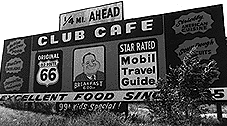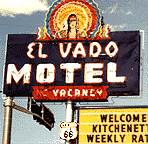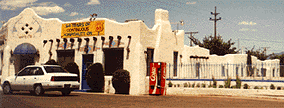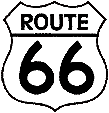Day 60 -- Monday, June 29
Traveling 66 between Tucumcari and Albuquerque, one is faced
with a decision. The original alignment of the Mother Road included in its
meanderings the capitol city of Santa Fe; later, the route was straightened out,
becoming a relatively straight path through the state. I was tempted to take the
long route through Santa Fe but, in the end, time constraints led me to opt for
the more direct route.
The old route through this portion of New Mexico
snakes, as frontage road, from the north side of I-40 to the south and back
again. Eventually, though, one is forced to submit to the ever-ravenous
super-highway. Exiting Cuervo, if one is a daring soul, one can travel a
really old, overgrown stretch of 66. I was feeling lucky so off I went.
This
is an old stretch, too. It heads south and west, away from the interstate, off
into no man's land. The pavement is barely discernible through all the rocks,
dirt and flora and is a potholed obstacle course far more suited to travel in a
4-wheel-drive all-terrain vehicle than the little Ford Escort that I'm piloting.
Once I had committed to this stretch of road, I spotted not a single sign of
human life. Not a decrepit trading post collapsing in on itself, not the skeleton
of an abandoned automobile rusting in the sun, not even a candy bar wrapper did I
see blowing by in the unhindered breeze; just miles and miles of scrub brush,
tumbleweeds and cactii. The sun was burning brightly up above and I couldn't help
but think what a mess I'd be in if one of those infernal potholes took a big bite
out of one of my tires or a fan belt threw in the towel or the radiator blew its
top (I had plenty of gas, that was the one thing I wasn't worried about).
It was kind of exciting, though, to experience what it must have been like for
early long-distance travelers. After all, when Route 66 was officially
commissioned in 1926, only about 800 of the road's 2,448 miles were paved, and
there certainly weren't gas stations, motor courts and restaurants every few
miles. Such oases were scarce and traveling between them required advance
planning.
Eventually, this beat-up old stretch of pavement merged into state
highway 156, which is pretty darned deserted itself. Eight or ten miles farther,
Santa Rosa, my intended lunch stop, came into view.
 Santa Rosa features a number
of establishments remaining from the old road's heyday, but for my money, there's
only one place to dine, the Club Cafe. This eatery has been serving up
southwestern grub, from enchiladas to chicken-fried steak, since 1935. The cafe's
roadside advertising has, for most of those years, featured a winning caricature
of a smiling, heavyset guy, affectionately known as The Fat Man. The Club
Cafe's original owner, Phil Craig, came up with the idea. He wanted to create an
image of someone who appreciates good food, someone who has a satisfied air about
him. Artist Jim Hall created the image and the Fat Man has been smiling at
motorists from the side of the road ever since.
Santa Rosa features a number
of establishments remaining from the old road's heyday, but for my money, there's
only one place to dine, the Club Cafe. This eatery has been serving up
southwestern grub, from enchiladas to chicken-fried steak, since 1935. The cafe's
roadside advertising has, for most of those years, featured a winning caricature
of a smiling, heavyset guy, affectionately known as The Fat Man. The Club
Cafe's original owner, Phil Craig, came up with the idea. He wanted to create an
image of someone who appreciates good food, someone who has a satisfied air about
him. Artist Jim Hall created the image and the Fat Man has been smiling at
motorists from the side of the road ever since.
The cafe's current owner, Ron
Chavez, worked in the restaurant as a kid. He began shining shoes out front, then
became a busboy, a dishwasher and a cook. So, it was a dream come true when, in
1973, he was able to purchase the then-struggling cafe and bring it back to life.
The Club Cafe has a gift shop, too, offering Route 66 souvenirs, salsa seasonings
and Club Cafe T-shirts. Stop by for some cheese enchiladas; they're mighty
delectable.
Moving on towards Albuquerque, one encounters a couple of tiny
towns: Cline's Corners, basically just a touristy souvenir shop, and
Moriarty. This last put me in mind of Dean Moriarty from Kerouac's
classic, On The Road, a great book which devotes much of its ramblings to
66.
 One can take the old road almost all the way into
Albuquerque, where it's called Central Avenue. In most of the larger towns along the way, I've
come across a run of still-operating Route 66-era motels and motor courts; this
held true in Albuquerque, too. And how. There are dozens of motels along Central,
dating from the '40s and '50s, in various states of repair and disrepair.
Many, like most of the other structures in town, are stucco-covered adobe. Some
of them seemed to be oriented to booking by the hour, a number qualified for
flea-bag status but quite a few were modestly habitable. I would peg the El Vado
on the western edge of town as the place to stay. It's been there over 50
years and looks great.
One can take the old road almost all the way into
Albuquerque, where it's called Central Avenue. In most of the larger towns along the way, I've
come across a run of still-operating Route 66-era motels and motor courts; this
held true in Albuquerque, too. And how. There are dozens of motels along Central,
dating from the '40s and '50s, in various states of repair and disrepair.
Many, like most of the other structures in town, are stucco-covered adobe. Some
of them seemed to be oriented to booking by the hour, a number qualified for
flea-bag status but quite a few were modestly habitable. I would peg the El Vado
on the western edge of town as the place to stay. It's been there over 50
years and looks great.
 Fortunately, I didn't have to make
a choice. I was to be the guest of the very hospitable Shelly and Bill Blanchard,
Albuquerque residents. Shelly is a dear friend I've known since college and Bill
is her husband. We spent my first evening in town taking a motor tour of the
city, enjoying some Mexican eats and topping it all off with dessert and
cappucino. A fine evening all around.
Fortunately, I didn't have to make
a choice. I was to be the guest of the very hospitable Shelly and Bill Blanchard,
Albuquerque residents. Shelly is a dear friend I've known since college and Bill
is her husband. We spent my first evening in town taking a motor tour of the
city, enjoying some Mexican eats and topping it all off with dessert and
cappucino. A fine evening all around.
 Santa Rosa features a number
of establishments remaining from the old road's heyday, but for my money, there's
only one place to dine, the Club Cafe. This eatery has been serving up
southwestern grub, from enchiladas to chicken-fried steak, since 1935. The cafe's
roadside advertising has, for most of those years, featured a winning caricature
of a smiling, heavyset guy, affectionately known as The Fat Man. The Club
Cafe's original owner, Phil Craig, came up with the idea. He wanted to create an
image of someone who appreciates good food, someone who has a satisfied air about
him. Artist Jim Hall created the image and the Fat Man has been smiling at
motorists from the side of the road ever since.
Santa Rosa features a number
of establishments remaining from the old road's heyday, but for my money, there's
only one place to dine, the Club Cafe. This eatery has been serving up
southwestern grub, from enchiladas to chicken-fried steak, since 1935. The cafe's
roadside advertising has, for most of those years, featured a winning caricature
of a smiling, heavyset guy, affectionately known as The Fat Man. The Club
Cafe's original owner, Phil Craig, came up with the idea. He wanted to create an
image of someone who appreciates good food, someone who has a satisfied air about
him. Artist Jim Hall created the image and the Fat Man has been smiling at
motorists from the side of the road ever since. One can take the old road almost all the way into
Albuquerque, where it's called Central Avenue. In most of the larger towns along the way, I've
come across a run of still-operating Route 66-era motels and motor courts; this
held true in Albuquerque, too. And how. There are dozens of motels along Central,
dating from the '40s and '50s, in various states of repair and disrepair.
Many, like most of the other structures in town, are stucco-covered adobe. Some
of them seemed to be oriented to booking by the hour, a number qualified for
flea-bag status but quite a few were modestly habitable. I would peg the El Vado
on the western edge of town as the place to stay. It's been there over 50
years and looks great.
One can take the old road almost all the way into
Albuquerque, where it's called Central Avenue. In most of the larger towns along the way, I've
come across a run of still-operating Route 66-era motels and motor courts; this
held true in Albuquerque, too. And how. There are dozens of motels along Central,
dating from the '40s and '50s, in various states of repair and disrepair.
Many, like most of the other structures in town, are stucco-covered adobe. Some
of them seemed to be oriented to booking by the hour, a number qualified for
flea-bag status but quite a few were modestly habitable. I would peg the El Vado
on the western edge of town as the place to stay. It's been there over 50
years and looks great. Fortunately, I didn't have to make
a choice. I was to be the guest of the very hospitable Shelly and Bill Blanchard,
Albuquerque residents. Shelly is a dear friend I've known since college and Bill
is her husband. We spent my first evening in town taking a motor tour of the
city, enjoying some Mexican eats and topping it all off with dessert and
cappucino. A fine evening all around.
Fortunately, I didn't have to make
a choice. I was to be the guest of the very hospitable Shelly and Bill Blanchard,
Albuquerque residents. Shelly is a dear friend I've known since college and Bill
is her husband. We spent my first evening in town taking a motor tour of the
city, enjoying some Mexican eats and topping it all off with dessert and
cappucino. A fine evening all around.